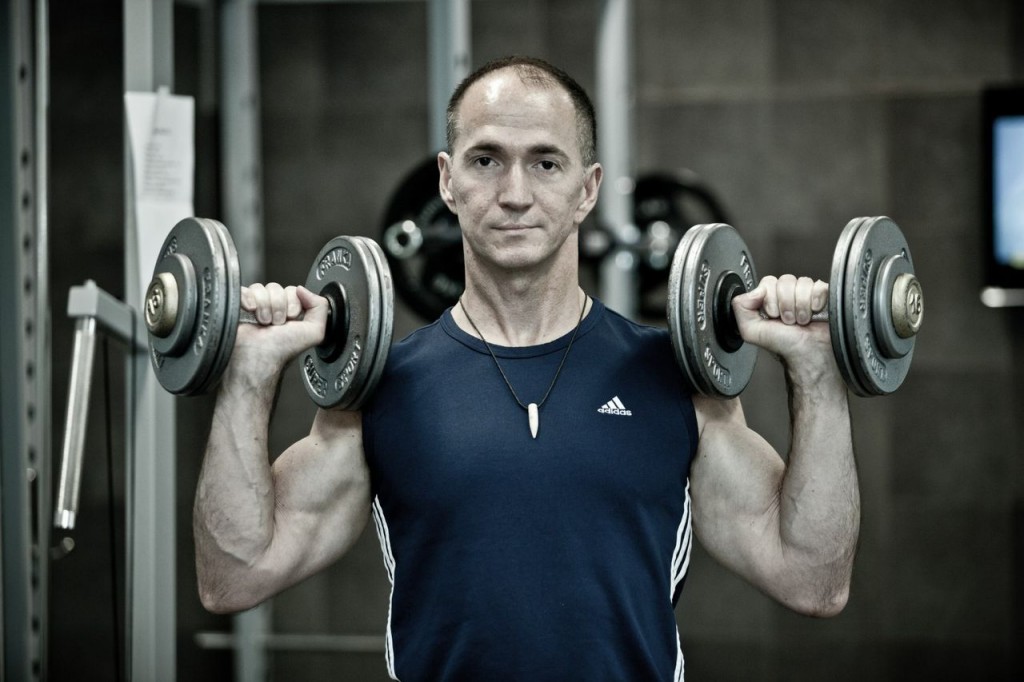You’re never too old to start weight training, not over 40, and not over 60! Weight training will crank up your metabolism, prevent muscle loss, and strengthen your bones and bone density.
- You will look and feel better about yourself.
- You will have more confidence in yourself, both personally and professionally.
- You will be more focused and determined and you’ll even sleep better.
- Plus, you will have an improved sex life because weight training helps to keep your testosterone at normal levels. This is important because beginning around the age of 30, your testosterone levels begin to decline, and continue to do so as you get older.
Here are some important rules for weight training over 40 to help you get started:
Go Slowly
If you are a beginner, or someone who’s taken a break for a few years, it’s always better to take it slowly. Give your body time to adjust and adapt to this new challenge. This will help you avoid injury and keep yourself from burning out. Weight lifting is an intense activity. Listen to your body and give it time to absorb the change so you can be more aware of your body and what its doing.
Hire a Personal Trainer
You can find many weight training programs online and in fitness magazines. Hiring a good personal trainer, at least for the first few weeks, can help you get started with a balance program and help make sure you are using the correct form to avoid injury. As we get older, we have to pay special attention to our joints, cartilage, tendons and ligaments. A personal trainer can also help you get maximum results in minimum time with a customized program designed especially for you. If you are someone who needs constant motivation, you may want to hire a personal trainer for a longer period, if your budget allows it.
Train at the Right Frequency
In your 20’s or 30’s, weight training five times a week was probably not a problem. In your 40’s, your body needs more time to recover between workouts. Training three to four times a week will give you ample time to recover and achieve your goal.
One important factor you must not forget is that muscle grows while your body is at rest and not while you are working out. Give your muscle tissues time to repair and rebuild themselves so they are bigger and stronger. As your lean muscle increases, your resting metabolism will increase, so you actually burn more calories all day long. Proper sleep is also vital to muscle repair and hormone production.
Eat the Right Foods
Working out is only part of the equation to reach your goal. The right foods will fuel your workouts and help you with recovery. Maintaining good eating habits can improve your overall performance and increase muscle strength. Skipping this part will drastically slow down your progress and result in a loss of motivation due to slow results.
The goal for most men over 40 is to have a lean muscled body.
- If you are already at your ideal weight, you should slightly increase your calorie intake based on a muscle building diet and your Basal Metabolic Rate (BMR).
- If you are slightly overweight, you should base your calorie intake on your BMR and add the weight training to help you lose extra fat and gain muscle. As soon as you have reached your ideal weight, start adding calories to balance your energy requirements so muscle mass is not used for an energy source by your body.
- If you are obese, you should try to consume 500 to 600 calories below your BMR and add weight training for extra calorie burning.
Stretching (No Exceptions!)
Stretching was important when you were younger but now that you are in your 40’s, it’s even more essential. As we age, our joints tighten. Stretching loosens our joints and muscles and improves our range of motion (ROM), resulting in improved performance. Stretching improves your flexibility, which can improve your performance in physical activities and decrease your risk of injury because it helps your joints move through their full range of motion. It also increases blood flow to your muscles.
Before your workout, focus more on dynamic stretching. After your workout, focus on static stretching. Never skip it, stay flexible!
Include Core and Balance Training
Core training helps you keep your core strong and helps you to avoid back and posture problems. It helps to stabilize and align the spine, ribs and pelvis and can also help improve respiratory function.
One thing that we seem to lose as we age is balance. Try to incorporate some balance exercises in your training sessions a few times a week. It helps improve the communication between your brain and your muscles. During balance training, your body has to work harder so you actually burn more calories.
Improve Your Total Weight Training Volume
Keep a log of your exercises and the amount of weight you lifted each time you workout. After each workout, total the amount of weight you lifted. The next time you do the same workout routine, try to increase the total amount of weight you lift. It doesn’t matter which specific exercise(s) within the program you increase, as long as the total weight that day is higher. You can also apply this technique with sets and reps but keep in mind you don’t want to exceed 30 sets per workout.
It’s never too late to start weight training. Age is just a number so, unless you have a medical issue that prevents you from doing physical activity, the only thing stopping you is you! Just keep in mind these rules above and focus on form and balance and you will reach your goal.
PS: If you are over 40 and have never done physical activity or if you have been away from it a while, I would suggest visiting your general practitioner (GP) for a quick physical to make sure there are no medical issues preventing you from exercising.



